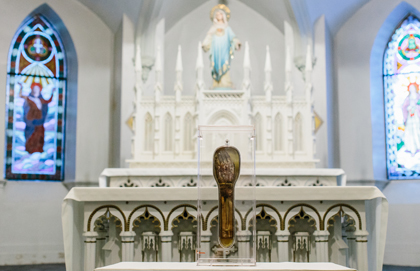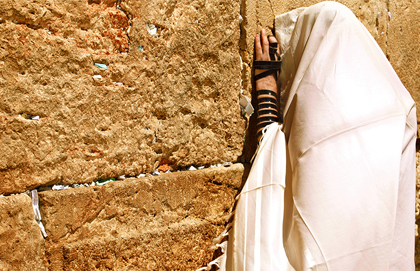Know this, children, that just as a house attests to a builder, and a garment to a weaver, and a door to a carpenter, the world is and will be God's testimonial; one has only to look at it to understand that what it affirms is God.
—Rabbi Akiva
Word of God has come to us through the mouths of His creations; Adam, Moses, then the judges and finally the prophets; Micah, the last, told us what the Lord requires of us:
Only to do justice,
And to love goodness,
And to walk modestly with your God.
There are those who believe that God stopped speaking to us after the prophets. This is not true. Messengers of God still speak to us, but in different voices: Saint Francis of Assisi through reverent actions and his own words; and Sandro Botticelli, through art.
I was in a bookstore in Rome when I came across the biographies of Saint Thomas Aquinas and Saint Francis of Assisi by G.K. Chesterton. How serendipitous. What better way to spend time than in the company of two revered saints. It turned out, for me, that Chesterton's company was a problem. He weaves a web of words that ties me up in knots.
When I returned home, I expressed my frustration to Peter Stockland, Convivium's publisher. His response: "Reading a typical Chestertonian sentence is like watching a man carrying a bowl of milk as he enters a house through the front door and seeing him come back out through a window carrying a white cat. You know something happened inside that was a natural miracle, and it doesn‘t really matter if you can‘t express what it was."
And then it happened. A miracle. Well into the book, I came across a few sentences that opened the door to unravelling the mystery hidden within Chesterton's words. He wrote about Saint Francis: "Even in that fairy borderland of his mere fancies about flowers and animals and even inanimate things, he retained this permanent posture of a sort of deference." And a few lines later: "... Saint Francis deliberately did not see the wood for the trees." For me, these phrases unlocked the essence of Saint Francis. He looked at each thing, individually, as unique.
I was reminded of the fact that no two snowflakes are alike, that there are more than 20,000 types of butterflies. It is almost unimaginable. I take the position of Charles Darwin: "I cannot think that the world, as we see it, is the result of chance; and yet I cannot look at each separate thing as the result of design."
Whether our world was created by chance or design, Saint Francis, born in Assisi in the late 12th century, teaches us to be in awe of all of God's creations, great and small, including the inorganic, because each is specialandunique.WereadinGenesis,"And God saw all that He had made, and it was very good."
Chesterton writes that Saint Francis was a simple man. And yet it is in his simplicity that we find a certain depth of complexity. I am sounding Chestertonian. Saint Francis calls us to focus on each and every detail, to appreciate the minutiae of life, perhaps to remind us that life is lived in the details. I think that appreciation enables us to feel more significant in the universe, because everywhere we look, we find ourselves surrounded by God; and because we are surrounded by all His creations, we feel less alone.
Saadia Gaon, born in Egypt in 882, a leader in the rationalist movement of Jewish philosophy, wrote about our place in the universe:
"For even though his body be small, his soul is wider than the heavens and earth, since his knowledge embraces everything that is in them, rising to an apprehension of what is above them, and of that in which they have their being; namely, the Creator, may He be blessed....
We are grounded in His world; we are not just a speck in time or space but part of a grand design. This idea of reverence for each creation is part of the mysterium tremendum of God.
Saint Francis' pulpit was in the open air. He wrapped himself in the goodness and bounty of nature and creation, expressing his gratitude for the blessings of life. He saw in everything something of the divine. To know God is to immerse ourselves in the study of all His creations. Saint Francis united the beauty in nature with the goodness in God as self-reflective. He lived his life in constant awe of creation and re-creation of ever changing nature, teaching us that we are all constantly changing, re-creating, evolving.
I was first introduced to the teachings of Saint Francis when my good friend, Cathy, took me to her church for the Blessing of the Animals with my dog, Freckles, a white and blond cocker spaniel with attitude. Saint Francis of Assisi initiated the blessing of the animals about 800 years ago. He is credited with introducing the idea that human beings are only one of a myriad of creations of God and all are blessed in God's eyes.
It was a glorious day, the weather and the experience. Freckles, sporting her finest, special-occasion pink collar, was getting on in years and had arthritis. When the priest, dressed in the robes of the Franciscans, a corded belt around his waist, came out into the tree-lined courtyard at the back of the church, he was greeted by many families with little people holding anxiously onto their plethora of pets: cats and dogs, as expected, and gerbils and hamsters, parrots, rabbits and fish. The priest divided the group into Catholic pets and the rest of the pets. My Freckles was "Jewish."
The priest came to each pet and blessed it. For those pets not Catholic, he gave what I know as the Priestly Blessing:
The Lord bless you and keep you.
The Lord make his face shine upon you and be gracious to you.
The Lord lift up His countenance upon you, and give you peace.
And then he placed his hands on my beloved puppy, spoke gently to her and talked softly to me. And as odd as this may sound, it reminded me of feelings I experienced when a priest would come to comfort one of my Catholic patients: the presence of love, for both of us.
I recently read that there is a history of blessing the animals in Judaism that originated in ancient times. The Jewish ceremony is often performed on the seventh day of Passover as a celebration of the Hebrews' – and their animals' – emancipation from slavery in Egypt more than 3,000 years ago. There are some congregations that provide this ceremony in the fall during the Jewish High Holidays when the Bible story about Noah and the Ark is read. God promised never to destroy the earth again. Needless to say, both humans and animals were understandably joyful. What a perfect setting for a blessing.
In 1205, not long after his return to Assisi, Francis was praying before an ancient crucifix and heard a call from God that he was to rebuild the Church. Literally. The chapel of St. Damian's below the town was in disrepair. And figuratively. It was more than his hands that were needed to rebuild this small church; he was to use his words to rebuild faith in the Church, faith through a love of God's creations.
I read that Saint Francis and the legend that grew around him became a much beloved subject for artists, especially within the mystical Umbrian school. Francis himself wrote:
"He who works with his hands is a labourer. He who works with his hands and his head is a craftsman. He who works with his hands and his head and his heart is an artist."
He declared that the duty of a servant of God was to lift up the hearts of men and move them to spiritual gladness.
Sandro Botticelli was one of the leading painters of the Italian Renaissance. He has been described as a poetical painter. It was his 1481 painting, La Primavera (Spring) in the Uffizi Gallery in Florence that caught my attention and lifted my heart to spiritual gladness. Botticelli was known for bringing Christian and classical ideas together in his artwork. And this painting has an enchanting, spiritual quality about it. At first glance I thought I was looking at a painting of the Madonna. Art historians refer to his elegant execution, his sense of melancholy, and his strong emphasis on line; details appear as sumptuous "still life." I recently read that the way to greater levels of spirituality is by paying attention to the most trivial matter, to the smallest of details.
Botticelli, like Francis, was captivated by details. La Primavera embraces you in the natural beauty of the infiniteness of the physical environment and releases within a sense of universal love and happiness.
Botticelli apparently painted this canvas as a wedding gift for a member of the Medici family. It hung in the Villa di Castello and was meant to be displayed in the privacy of the couple's bedroom. The boughs of oranges in the background symbolize fertility, a hope for the blessing of children. Over the centuries, others have added new interpretations. And so, today, we have a gift with many layers of meaning. Yet there still remains an abundance of opportunity to go deeply into the "text" to search for personal meaning, as we do with any brilliant piece of work that freezes a moment in time.
There are art historians who see the painting as "an elaborate mythological allegory of the burgeoning fertility of the world." Some describe the beautiful angelic woman in the centre, surrounded by boughs of oranges, as Venus; others, as the Virgin Mary, the one with modest grace and beautiful eyes full of infinite tenderness. Many scholars have noted a resemblance between Botticelli's Venus or Mother Goddess and his images of the Virgin Mary. As one critic wrote, the Venus of La Primavera is in a way the Pietà.
The impish cherub above appears to be Cupid. The three dancing figures on the left are said to be the Three Graces, charm, beauty and creativity, who in Greek mythology represent poetry, art, music, virtue and knowledge. They dance with careless abandon, reminding me of my granddaughter when she sways with joyful, angelic abandonment to the music swirling in her head. Mercury waits, looking outward into the distance. Another critic wrote that as Mercury is the god of wisdom, the one who knows about the occult mysteries of the universe, the art of alchemy and the cosmic forces, the painting proffers the suggestion that to find wisdom and to achieve eternity, one has to renounce physical pleasure, which is temporary and incomplete.
On the far right is Zephyr, representing winter, and I see him as trying to hold on to Chloris, who is holding the first blossoms of spring, not wanting her to bloom. But the life cycle must continue and Chloris transforms into Flora, the goddess of flowers and blossoms, sheathed in flowers, pregnant with spring.
It wasn't until I returned home that I learned that La Primavera is reminiscent in style of Flemish tapestries, which were desired in the Florence of Botticelli's time. Like the tapestries, the characters in it are almost life-sized. I wasn't aware of that when I bought a life-sized tapestry of La Primavera when we were in San Gimignano in Tuscany. The tapestry now holds centre stage on a family room wall.
It was just after I decoded Chesterton that I looked with new eyes at the tapestry, a representation of a painting that depicted a tapestry. And I made the connection between Assisi and Botticelli and ultimately back to the wonder of God.
La Primavera is overflowing with natural wonder, a plethora of flowers strewn across the canvas, paying homage to nature's abundance. And then I read that there are more than 500 identified plant species throughout the painting, with about 190 different flowers and, of those, at least 130 have been specifically named. In the original painting, no two flowers are identical. Three hundred years after Assisi, Botticelli brought to his canvas an echo of a divine voice, Assisi's joy and love of the profusion of species in nature and of the importance of paying attention to details:
"Praised be You my Lord through our Sister, Mother Earth, who sustains and governs us, producing varied fruits with coloured flowers and herbs."
—Canticle of Brother Love and Sister Moon
If you accept one of the interpretations of La Primavera, that Mercury represents one renouncing physical pleasure, which is temporary and incomplete, then Botticelli and Assisi are brothers in spirit. Botticelli, the artist from the 15th century, by depicting Mercury, was expressing life values similar to Assisi, from the 12th century. Assisi had renounced the way of the material world and the wealth of his family and had chosen to live a more spiritual life, renouncing physical pleasure and embracing poverty, purity, chastity and morality.
At the turn of the Common Era, Philo, a great Jewish philosopher, wrote: "God speaks not words but things," and as creative energy, it flows down and "overflows and gladdens all things," which inspires us to great undertakings. Botticelli, the artist, brings Assisi's spiritual gladness to a grand canvas – a gratitude for all the blessings in life. Both messengers of God, they inherently knew that God's light of awareness cascades down on us as we reach up to Him and that it is through God's creations that we can come to know and love Him.
Unlike paganism, which worships nature, we worship the Creator of nature. Assisi articulated these beliefs through reverent actions and his own words; Botticelli expressed that love through reverential strokes of the brush. La Primavera speaks to creation and recreation, from the cold and death of winter to the fecundity of spring and summer and back again. Botticelli's attention to detail, the cacophony of flora, no two the same, is an echo of Assisi's words of awe and wonder in the multiplicity of God's creations.
Like a symphony audience caught by the sound of the individual notes of the violin, flowing into all the notes of the string instruments with piercing clarity, we are encircled by the work of the artist, God. And we come to respect all of His creations, animate and inanimate, and develop a reverence for them and hopefully a desire to protect, wrapped in an all-encompassing empathy.
Reading about Botticelli and Assisi, I came across this statement that was written about one, but rests comfortably on both: The whole world was to him one luminous ladder, mounting upon the rungs of which he approached and beheld God. The legacy of Assisi and Botticelli is the ascent to the holy that they bequeathed to us through their work. Sadly, today, we are inundated with distractions, so much so that life gets in the way of living. Our hunt for happiness blinds us to the free gifts before us, keeping us from beholding God. There is a beautiful Hebrew prayer, the Shekhyanu, which reminds us to be grateful for this moment in time and for an awareness of the abundance of God's gifts.
"Blessed are You, Lord, our God, King of the universe, Who has kept us alive, sustained us, and enabled us to reach this season."
We live in a time when so many search for meaning, a sense of belonging, a connection to the ephemeral, to the holy. Botticelli and Assisi remind us that God speaks to us through many messengers from many places. We just need to take a moment and listen, through all of our senses.






